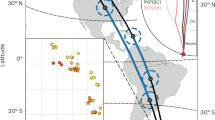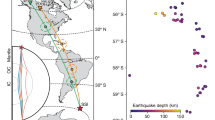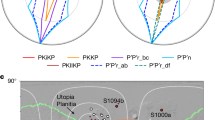Abstract
A THEORETICAL calculation by one of us1 shows that, if the earth's inner core has a rigidity comparable with its incompressibility, then the seismic phase PKJKP would, on present available knowledge, be most likely to be detected over a range of epicentral distance Δ given by 130° ⩽ Δ ⩽ 155°, the expected energy and amplitude in this phase being about 0.04 and 0.2, respectively, of that in the companion phase PKIKP. The phase PKJKP appears, therefore, to be on the border of observability and, if the solidity of the inner core is to be established, it becomes important to investigate the practical question of detecting a phase of such low amplitude.
This is a preview of subscription content, access via your institution
Access options
Subscribe to this journal
Receive 51 print issues and online access
$199.00 per year
only $3.90 per issue
Buy this article
- Purchase on SpringerLink
- Instant access to full article PDF
Prices may be subject to local taxes which are calculated during checkout
Similar content being viewed by others
References
Bullen, K. E., Mon. Not. Roy. Ast. Soc., Geophys. Supp., 6, 163 (1951).
Bullen, K. E., Mon. Not. Roy. Ast. Soc., Geophys. Supp., 6, 125 (1950).
Bullen, K. E., “Introduction to the Theory of Seismology”, 209 (Camb. Univ. Press, 1947).
Author information
Authors and Affiliations
Rights and permissions
About this article
Cite this article
BULLEN, K., BURKE-GAFFNEY, T. Detection of S Waves in the Earth's Inner Core. Nature 170, 455 (1952). https://doi.org/10.1038/170455a0
Issue date:
DOI: https://doi.org/10.1038/170455a0



